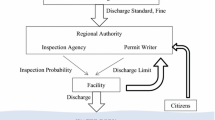Abstract
This paper summarizes the results of the first systematic, geographically-specific efficiency assessment of the U.S. experience with national environmental standards and with alternative approaches to establishing those standards. This ex-post evaluation assessed the net benefits that resulted from EPA's regulation of conventional air and water pollutants from the pulp and paper industry between 1973 and 1984. The paper compares the benefit-cost efficiencies of the three dominant regulatory approaches: technology, ambient, and benefits. Unlike previous studies, which assessed benefits and costs on a national basis, the study estimates both costs and benefits on a facility-by-facility basis. The analysis shows how the efficiency of national environmental regulations can vary dramatically at local levels. The authors conclude that the technology-based standards for water pollution management failed as an efficient environmental strategy. The costs clearly exceeded the benefits in the aggregate, as well as in the specific in most situations. Benefits exceeded costs at only 11 of the 68 mills investigated. The ambient based standards for air pollution management succeeded as an environmental strategy in the aggregate, but succeeded in the specific for only one-third of the mills (22 of 60 mills). The benefits-based standards for air pollution management also succeeded in the aggregate as well as in the specific for about one-half of the mills. Benefits exceeded costs at 29 of the 60 mills investigated. The results of the study point to two major conclusions. First, a regulatory policy that is based on some measure of environmental results, either ambient-based or benefits-based, will be more efficient than a policy that ignores environmental results. Second, truly efficient policies for reducing environmental risks require pollution mitigation decisions that take into account local conditions. These include not only the changes in local ambient conditions, but also the number of people who will benefit from pollution reduction decisions. This latter conclusion suggests that national environmental standards per se may be inefficient.
Similar content being viewed by others
Author information
Authors and Affiliations
Additional information
Dr. Luken is currently Senior Environmental Advisor to the United Nations Industrial Development Organization (UNIDO) in Vienna, Austria. He is on leave from the U.S. EPA where he was Chief of the Economic Analysis and Research Branch of the Office of Policy, Planning and Evaluation (OPPE). Mr. Clark is President of Environmental Economics Associates of Traverse City, Michigan. He was formerly Chief of EPA's Cost and Economic Impact Analysis Branch in OPPE. The views expressed are those of the authors and do not represent the views of the U.S. Environmental Protection Agency.
Rights and permissions
About this article
Cite this article
Luken, R.A., Clark, L. How efficient are national environmental standards? A benefit-cost analysis of the United States experience. Environ Resource Econ 1, 385–413 (1991). https://doi.org/10.1007/BF00377494
Issue Date:
DOI: https://doi.org/10.1007/BF00377494




